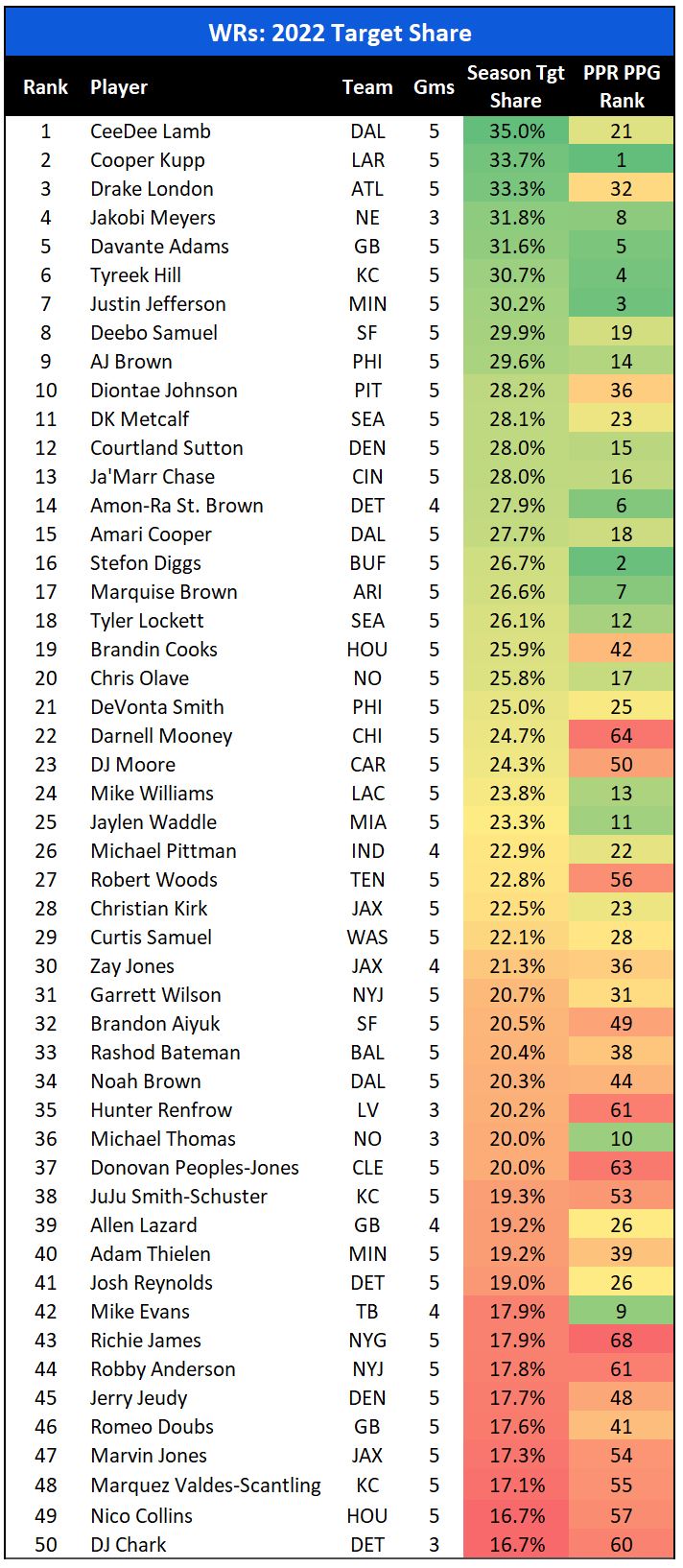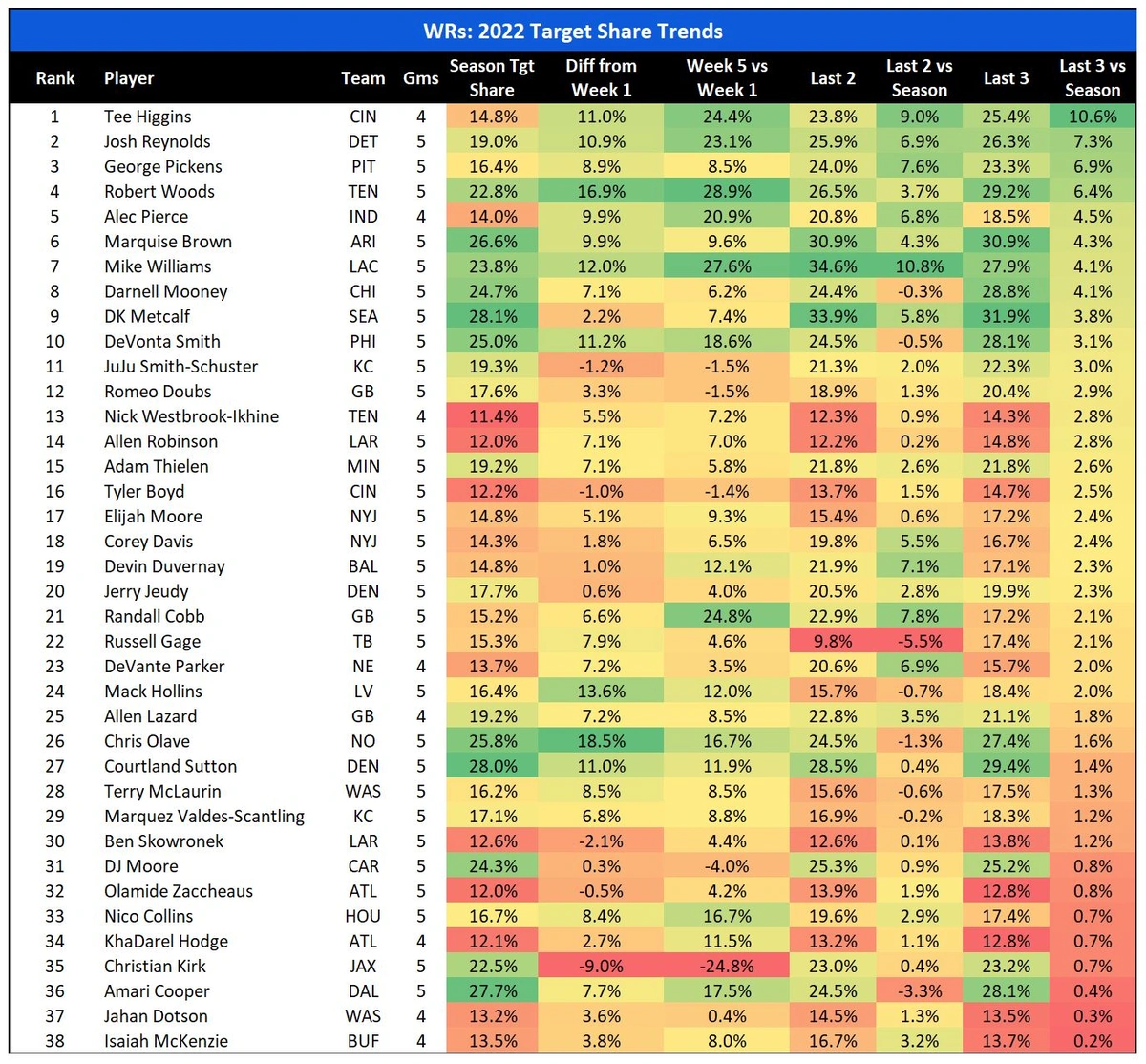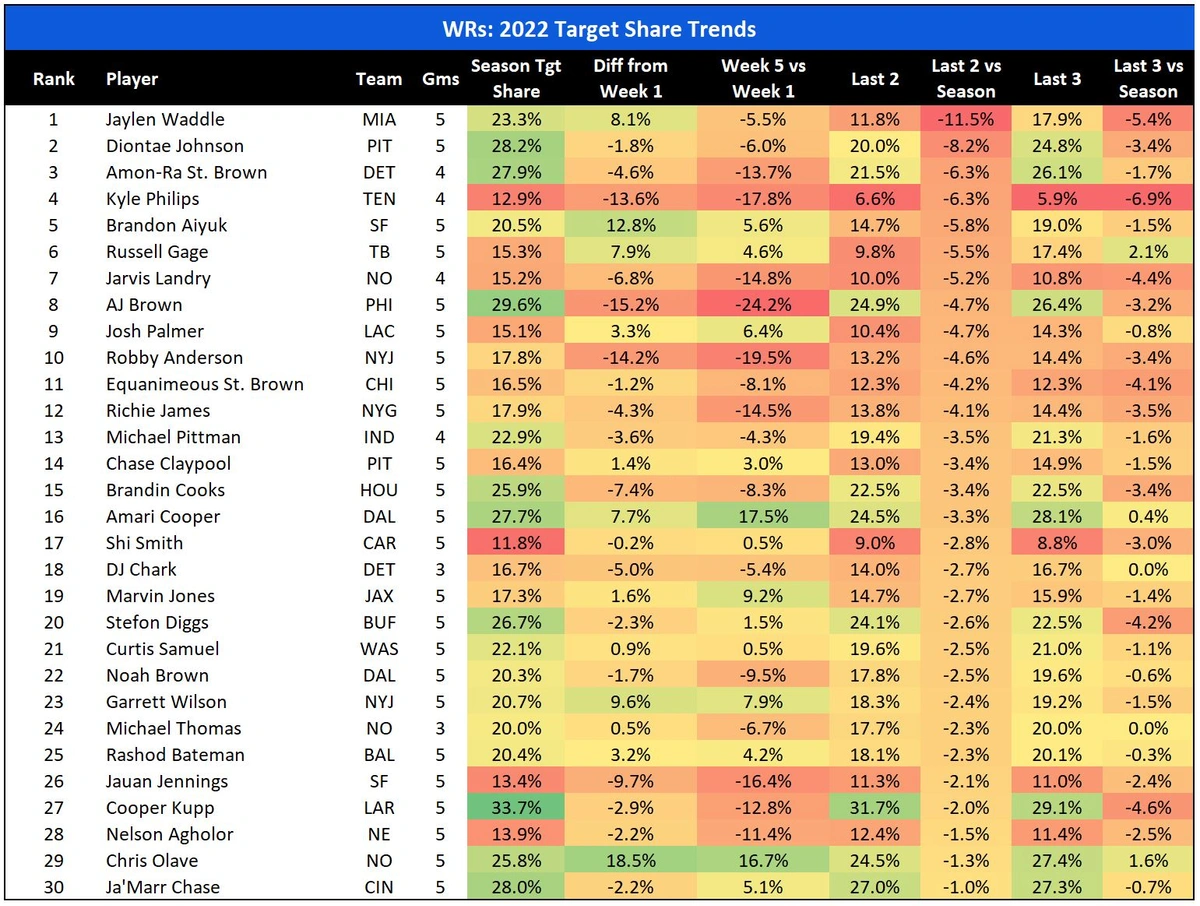Fantasy Football Beneath the Surface: Week 6
Another week of NFL football, another pile of data to sift through looking for clues. Clues as to what leads to certain results and clues for speculating what might be coming next. They say, “looks can be deceiving.” The same can be said for surface-level statistics in fantasy football. In this weekly article series, I will be looking beneath the statistical surface, beyond the standard box score, using the premium statistics provided by FantasyData, including advanced and efficiency metrics across the fantasy skill positions, to search for puzzle pieces that fit together.
Popular Links
Market Share Trends
We move on to Week 6 of the 2022 NFL Season. And with that, even more data has accumulated that we can sift through looking for useful trends. Entering Week 4 I wrote a piece focusing on market share trends. Specifically, I looked at snap share rates for WRs and RBs and showed some positive and negative trends among players in those positions. You can find that article here
For this article, I want to continue looking at market share trends but get a little closer to the actual production. Snaps tell us a player was on the field. But target share (WRs) sheds light on an offense’s intent to get the ball into the player’s hands, or, more accurately, the share of a team’s passing market a player is earning. With pass catchers, target share alone can be misleading in some cases and does not necessarily correlate directly with fantasy points.
Darnell Mooney for instance. The Bears’ WR currently has a target share of 24.7%, a solid number that is 22nd among WRs. However, he sits at WR64 on the season with only 6.8 PPR fantasy points per game (PPG) (minimum of three games played). There are multiple reasons why Mooney’s target share has not translated to fantasy production. But you do not need to dig far for the main reason. Simply put, the Bears’ offense has been terrible. Through five games, the Bears are dead last in pass attempts (17.6), completions (9.8), and WR targets (9.4) per game. The Bears are also the only team in the NFL that has averaged less than 50 offensive plays per game (49.3). Add to all of that Justin Fields’ league-low 55.7% completion rate, and what you have is the worst passing market in the league from which to share. Mooney has shown signs of fantasy life recently with 94 receiving yards in Week 4 and 12 targets in Week 6’s Thursday Night Football game against the Commanders.
I am not here to trash Justin Fields or the Chicago Bears. The point here is to show how a solid target share can be misleading without context and the specific reasons why that is the case for Darnell Mooney. Mooney is the clear top passing option in Chicago, so I’m not cutting bait yet where I have him rostered. There has been improvement in the Bears’ offense, albeit barely discernible, so if Fields takes strides as the season progresses, Mooney can still be a good fantasy asset.
On the flip side is Gabriel Davis. Davis is the current WR19 in PPR with 15.0 PPG but ranks 72nd among WRs with a target share of 12.7%. This relatively massive discrepancy also has an uncomplicated explanation. Davis relies on huge spike weeks for his Top 20 WR PPG. He does not see a lot of targets, but a target for Davis has as good of a chance of resulting in a TD as anyone in the NFL. And that’s not just hyperbole. Davis’ 27.3% TD rate (TDs per target) is second to only Commanders’ rookie Jahan Dotson (33.3%) among WRs with at least 20 targets. But his TDs have also been huge plays. Davis’ three receiving TDs in 2022 have gone for 26, 62, and 98 yards.
Josh Allen and Gabe Davis WASTE NO TIME WITH A 98-YARD TD🔥
(@NFL)pic.twitter.com/qqIEL2PSCZ
— Bleacher Report (@BleacherReport) October 9, 2022
In PPR scoring, that is 39.6 fantasy points on three plays. That equates to 80% of his fantasy production. I am not one to say “but if you take away the long TDs” as a reason to knock a player. Long TDs are what we want. But I do accept what Gabe Davis is. He can win you your week like he probably did in Week 5. Or he can disappear, as he did in Weeks 2-4. You have probably heard the common phrase “what he’s doing isn’t sustainable.” Which is true for Davis. A 27.3% TD rate and his insane 5.4 fantasy points per touch are not sustainable over a full season. A fantasy output not being sustainable does not automatically mean “bad.” That’s the “or he can disappear” part. You just need to frame your expectations around Davis being the quintessential “boom-bust” WR, and his booms can be week-winning.
WR Target Share
You see that individual target shares are potentially not enough to tell the story or offer predictable, actionable fantasy projections. But if you expand that to target share trends, you can see which WRs are heading in positive or negative directions, which would not be visible when looking only at the season-long number. Before looking at some of the trends that have materialized, here are the Top 50 WRs based on overall target share, as well as their current rank in PPR PPG:
You can see our earlier discussion about the potential discrepancy between target share and fantasy production, generally speaking, is more of the exception than the rule. Only seven of the Top 30 WRs in target share are not also in the Top 30 in PPR points per game. However, a few players warrant discussion.
Drake London’s third-highest target share is impressive for a rookie, but like Darnell Mooney, the passing market in Atlanta has been well below league average. Only the Bears throw fewer passes per game, and only the Bears and Ravens have averaged fewer WR targets per game than the Falcons.
Diontae Johnson has the 10th-highest target share at 28.2%, but he’s barely in the Top 36 for PPR PPG. Only Brandon Cooks (whose discrepancy also stands out) has a Fantasy Points Over Expected (FPOE) lower than Johnson.
I wrote about Jakobi Meyers multiple times this past off-season. I liked his value with the increase in the volume he had seen each year of his career and projected him as the top pass catcher and the most fantasy-relevant WR in New England. I did not project a 30%+ target share and Top 10 PPR WR through five games.
Through 5 games, only 2 WRs have been >25% target share in each game played:
CeeDee Lamb
Deebo SamuelSeven WRs have been >30% target share in over half of their games played:
CeeDee Lamb
Cooper Kupp
Drake London
Jakobi Meyers👀
Justin Jefferson
Amari Cooper
Diontae Johnson pic.twitter.com/XPL6qJtFoa— Scott Rinear (@MunderDifflinFF) October 14, 2022
Mike Evans continues to do Mike Evans things, at least the Mike Evans of the last few seasons with Tom Brady. Since Brady came to Tampa Bay in 2020, Evans has been a sub-20% target share, 10%+ TD rate WR, leading to finishes of WR16 (2020) and WR11 (2021) in PPR PPG according to FantasyData. So, his current WR9 with a 42nd-highest 17.9% target share is not surprising. I have acclimated to this current version of Evans. Sometimes I forget that before 2020, from 2017-2019, Evans averaged a 23.5% target share and a 5.2% TD rate.
Tyler Lockett continues his pattern of being a highly productive yet underrated and underappreciated WR in the NFL. With a solid target share at 26.1% and a current residence in the Top 12 (PPR PPG), the veteran WR looks to be a steal at his draft price, especially with how well the Seahawks’ passing offense has looked since Week 3.
WR Target Share Trends
But now it’s time to look a little bit further below the surface, ignoring fantasy points for a moment and looking at target share trends. This allows us to look at some lesser-known WRs whose arrows are pointing up, who have not yet made much fantasy noise.
In addition to overall target share, the following group of charts includes:
- Difference between Week 1 target share (or first game played) and overall target share.
- Difference between Week 1 target share (or first game played) and Week 5 target share (or most recent game played)
- Target share over the last two games (Last 2)
- Difference between the Last 2 and overall target share
- Target share over the last three games (Last 3)
- Difference between the Last 3 and overall target share
The first chart is sorted by the last category, showing the 38 WRs with a positive difference between their Last 3 and their overall target share. I chose this as a filter because I think it is useful in showing WRs, not on as many fantasy rosters, who are trending in the right direction, even with a below-average overall target share.
Like any data set, this filter requires interpretation. Tee Higgins sits atop this list largely due to his Week 1 injury taking him out of that game. An in-game injury not only wreaks havoc on our fantasy teams but, especially in Week 1, started Higgins off at a very low target share. This takes time for a player to statistically recover from. With Higgins, using the Last 3 removes Week 1 whereas his overall target share includes it. The point is Higgins’ positive trend by this metric is not organic. It’s based on skewed data. Tee Higgins is still battling the ankle injury, but he is a must-start player when healthy.
It is the other names near the top of this list that are interesting. Amon-Ra St. Brown did miss a game, DJ Chark has missed two games, and D’Andre Swift is currently on the shelf and has been since Week 3. But Josh Reynolds has been heavily involved in the Lions’ passing game in recent weeks. Reynolds has the second highest number in this category, and his 26.3% target share over his last three games is the 20th-highest mark in that time frame. We will have to monitor this trend as the Lions’ pass-catching weapons get healthy, but Reynolds is showing some of the promise we were hoping for during his time with the Rams.
Rookie WR George Pickens is third with this filter, and his involvement has been steadily increasing. Rookie WRs typically take time to acclimate to the NFL, but I think we are seeing the beginning of his breakout. Pickens has seen at least seven targets over the last three games, including a total of 12 catches on 16 targets, and 185 receiving yards over his last two games. The QB change from Mitch Trubisky to rookie Kenny Pickett was inevitable in Pittsburgh, but that change in Week 4 coincides with that two-game stat line for Pickens.
Another rookie WR, Alec Pierce, is also on an upward trajectory. This was another sleeper I wrote about leading up to the season, as the Colts’ WR2 was up for grabs. Ashton Dulin showed a spark early in the season but is now on Injured Reserve. As much as I might want Parris Campbell to be a thing, he has not yet exceeded 4 targets or 43 receiving yards this season. Pierce is in the process of taking that WR2 role. Pierce started slowly (again, like most rookies), with only two targets and no catches in Week 1. He then missed Week 2 due to injury. But, since Week 3 he’s been climbing. His target shares in Weeks 3-5 were 13.9%, 16.7%, and 25.0%, respectively. In the Week 5 snooze fest against the Broncos, Pierce was a bright spot, catching eight of nine targets for 81 yards. Pierce is a great example of a player with a low overall target share, whose involvement has increased each of the last three games, culminating with the 16.1 PPR point day against a good defense in Denver.
Devin Duvernay has also caught my attention. After his Week 1 outing, in which he caught two TDs on only four targets, I called him a fantasy mirage because the fantasy result did not match the low volume. But, I did also say he was a player to monitor in case that volume was to increase. With Rashod Bateman battling injuries, that has been happening for Duvernay. Duvernay sits at 19th by this metric, but if you look at the past two games, he is above a 20% target share and has the 5th-highest difference between “Last 2” and overall target share. This has not yet resulted in much fantasy damage, and maybe this disappears once Bateman is fully healthy. The Ravens are last in the NFL in WR target share (41%), so the situation is not ideal, but Duvernay remains a player to monitor and stash in deeper leagues.
You can look at the chart and see some of the other positive trends (just look for the green), including Marquise Brown, Robert Woods, DK Metcalf, DeVonta Smith, Chris Olave, and especially Mike Williams.
With my formatting, where there’s green, there is also red. The following is the same data set filtered for negative trends in the difference between a player’s last two games and their overall target share.
The horrendous injury to Tua Tagovailoa has had (far less important) ripple effects on the Dolphins’ pass catchers, no one more so than Jaylen Waddle. It seems like a long time ago that Waddle and Tyreek Hill put up one of the highest combined scoring performances in fantasy football history. Over the last two games, Waddle’s target share has plummeted. His per-game target shares in Weeks 4 and 5 were 13.9% and 9.7%, respectively, an average 11.5% lower than his overall number. And it’s worse than that. His overall number (23.3%) is a product of those two games. Through three games, Waddle was sitting at a 27% target share.
Diontae Johnson is second on this list with a -8.2% compared to his overall target share, partly due to the ascension of George Pickens.
Amon-Ra St. Brown will be fine. He is third by this metric but that is largely due to the injury. St. Brown was above a 30% target share in both Weeks 1 and 2. And Week 5 was his first game back after missing Week 4, and his sub-20% target share (and the entire Lions offense) ran into a buzz saw playing in New England, and Jared Goff has regularly struggled against Bill Belichick.
Brandon Aiyuk has suffered the most following the season-ending injury to Trey Lance. Aiyuk’s trend has been in the wrong direction since his 33.3% target share in Week 2:
- Week 3: 27.6%
- Week 4: 16.0%
- Week 5: 13.3%
Next week I’ll be doing a similar breakdown of RB opportunity share trends through Week 6.
Thanks for reading! If you have any questions about the data used in this article or about fantasy football, feel free to hit me on Twitter.



